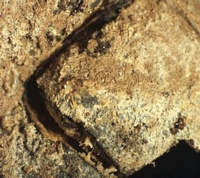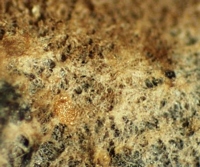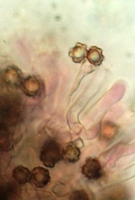|
 Tomentella epiphylla Tomentella epiphylla
BiostatusAbsent from region
Images (click to enlarge)
Caption: Tomentella epiphylla, BCP 3059
Owner: B.C. Paulus | 
Caption: Tomentella epiphylla, BCP 3059
Owner: B.C. Paulus | 
Caption: Tomentella epiphylla, BCP 3059
Owner: B.C. Paulus |
Article: Cunningham, G.H. (1963). The Thelephoraceae of Australia and New Zealand. New Zealand Department of Scientific and Industrial Research, Bulletin 145: 359 p. Wellington:.
Description: Hymenophore annual, membranous, loosely attached, effused forming small
irregular areas 2-4 x 1-2 cm; hymenial surface umber or sepia, granulose, not
creviced; margin thinning out, concolorous, loosely attached, fibrillose,
sometimes with scattered rhizomorphs. Context sepia, to 400 µm thick, a loose
weft of intertwined hyphae becoming erect beneath the hymenium, with in the base
numerous cordons to 50 µm diameter, composed of 20-35 parallel compacted hyphae;
generative hyphae 3.5-4 µm diameter in the subhymenium, in the base of the
context to 8 µm, walls 0.2 µm, thick, some roughened slightly, ferruginous,
tinted beneath the hymenium, freely branched at a wide angle, septate, with
clamp connections. Hymenial layer to 55 µm deep, of loosely arranged corymbs of
basidia, paraphyses, and occasional paraphysate hyphae. Basidia subclavate,
35-46 x 5-7 bearing 2-4 spores; sterigmata arcuate, slender, to 8 µm long.
Paraphyses clavate, 20-35 x 5-6 µm. Paraphysate hyphae projecting to 50 µm,
cylindrical, septate, to 5 µm diameter. Spores subglobose or oblong elliptical,
8-10 x 7-9 µm, walls strongly sinuate, coarsely sparsely echinulate, tinted
brown, 0.2 µm thick, spines to 2 µm long.
Habitat: HABITAT:
Bark or decorticated wood of dead branches.
Distribution: DISTRIBUTION: North
America, Great Britain, Europe, Australia.
Notes: Specimens agree
with collections of 'Hypochnus granulosus' examined in Kew herbarium.
The species may be recognised by the granulose surface, rather stout basal
hyphae, presence of large cordons near the base, strongly sinuate coarsely
echinulate spore walls, and dark colour of the context. Basidia and paraphyses
are grouped in corymbs, forming a loose palisade and giving to the surface its
granulose appearance. Cordons are conspicuous and may be seen with the aid of a
hand lens when the upper layer is dissected away. Because of their presence the
species was placed by Bourdot & Galzin (1928, p. 507) under the section
'Chordulatae', containing in addition T. rubiginosa (Bres.) Maire (with
two subspecies T. gresicola B. & G. and T. hasicola B.
& G.), T. coriaria (Peck) Bourd. & Galz., and T. botryoides
(Schw.) Bourd. & Galz. Burt at first used the name Hypochnus
granulosus for the species; later, following examination of the type of
Hydnum epiphyllum, he held (1926b, p. 320) that the correct specific
epithet was Hypochnus epiphyllus.
|